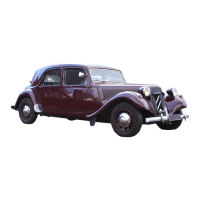1 - IGNITION
1a - Magneto or Delco?
With the exception of the 5000 first models produced, the 5HP were equipped with RB Type N10 / 4 magneto
Some have replaced this magneto on their car by a Delco, most of the time because it was broken or because
of its situation. The front end of the engine exposes it to ignition failure due to moisture.
But you should know that a magneto refurbished by a specialist is less expensive than the purchase of an angle
transmission and its Delco. It is very reliable, the proof it is still used in aviation to this day. With a magneto it
is always possible to start with the crank regardless of the state of the battery. For the sake of authenticity, it's
best to stick with the magneto.
In either case, fine-tuning the ignition requires care and patience, but nothing more.
1 b - Engine setting at Ignition Point ALL
You must first put piston no1 (near the radiator) at Top Dead Center TDC at the end of compression:
-To do this, after removing the spark plugs, gently crank the engine while keeping a finger on spark plug hole
no. 1 ( next to radiator ) ; every other turn, you can feel the compression and you can see, through the spark
plug hole, the piston reaching the top of the stroke. -
At this moment, the clutch housing cover having been removed, one of the six crown fixing bolt nuts, with the
letters "TDC" appears in the center of the window:… it is the top dead center and to its left, at 9.5 teeth is the
ignition point `` ALL ''
It suffices then to move the point ALL back to the right of the window then to bring it back under the mark
(needle stroke '' at 12 H '') on the clutch housing
This round trip is necessary to catch up with the play in gears. Without this, the contact of the platinum screws
will not be established at the same distance from the TDC when turning in one direction or the other.
The motor should therefore be set to the “ALL” point after having respected the direction of rotation of the
motor.
PHOTO PHOTO
Engine timed at TDC and engine timed with 5 tooth advance (ignore 3 punches above TDC
This is an easy and safe method, provided the engine has not experienced any hacks in a previous life. The
crown wheel could have been shifted by one or more sixths of a turn to correct the wear of the teeth by the
starter; similarly some rings from adaptation parts did not show any marking,
It is wise during a first adjustment to cross with another method for more safety.
For example, the coincidence between:
- the compression pressure through spark plug hole no1
- the position of piston no.1 at the top of the stroke,
- the latch of the exhaust valve of cylinder n ° 4 (last lug at the rear of the group) at the end of the
downstroke, which corresponds to the end of compression of cylinder n ° 1.
- the position of the large nut fixing the ring, at `` 12 o'clock '' opposite the point on the crankcase
… will allow you to find the correct positions of the TDC then of the ALL point then to mark them on the ring.
Some insist on using the old method of the beginning of the century (before) -last, of the "piston stroke" to
time the engine at TDC: you have to raise the piston in the compression phase and stop it 4.1 mm before TDC
(which is itself located 0.7 mm or 2.7 mmm below the edge of the cylinder, ... depending on whether the block
is short or long)
The piston being barely visible, it is almost impossible to wedge the piston correctly with the cylinder head in
place. For initiated or masochistic amateurs only!

